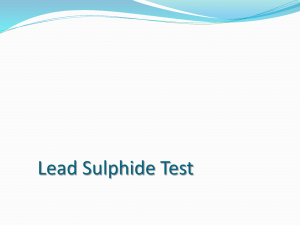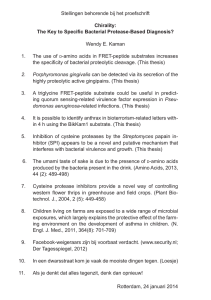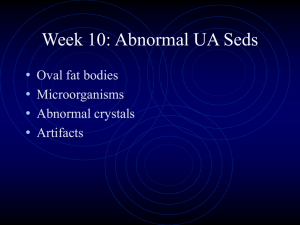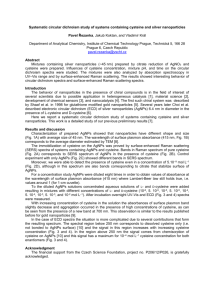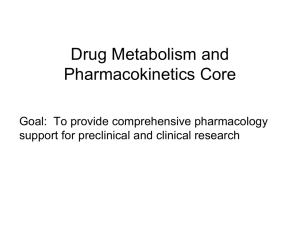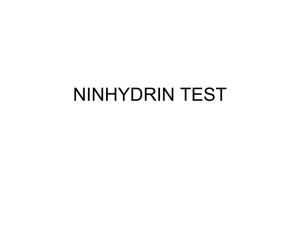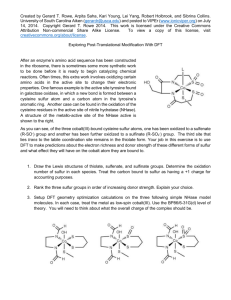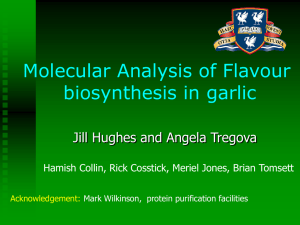Chapter.ID_5968_7x10CORRECTED
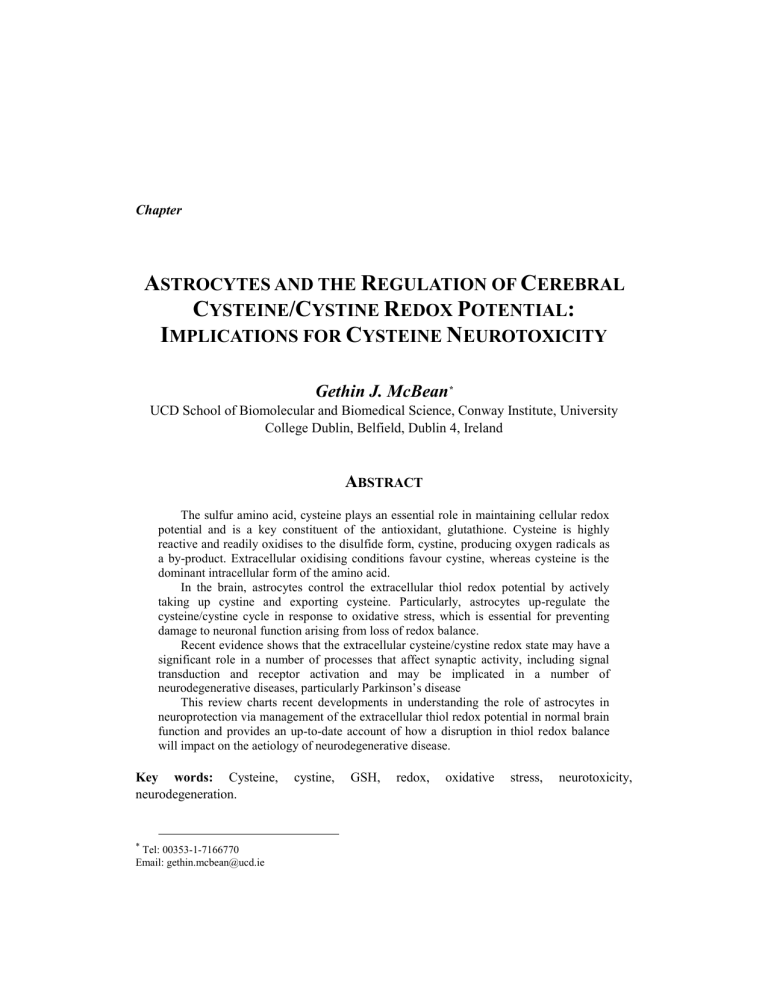
Chapter
A STROCYTES AND THE R EGULATION OF C EREBRAL
C YSTEINE /C YSTINE R EDOX P OTENTIAL :
I MPLICATIONS FOR C YSTEINE N EUROTOXICITY
Gethin J. McBean
*
UCD School of Biomolecular and Biomedical Science, Conway Institute, University
College Dublin, Belfield, Dublin 4, Ireland
A
BSTRACT
The sulfur amino acid, cysteine plays an essential role in maintaining cellular redox potential and is a key constituent of the antioxidant, glutathione. Cysteine is highly reactive and readily oxidises to the disulfide form, cystine, producing oxygen radicals as a by-product. Extracellular oxidising conditions favour cystine, whereas cysteine is the dominant intracellular form of the amino acid.
In the brain, astrocytes control the extracellular thiol redox potential by actively taking up cystine and exporting cysteine. Particularly, astrocytes up-regulate the cysteine/cystine cycle in response to oxidative stress, which is essential for preventing damage to neuronal function arising from loss of redox balance.
Recent evidence shows that the extracellular cysteine/cystine redox state may have a significant role in a number of processes that affect synaptic activity, including signal transduction and receptor activation and may be implicated in a number of neurodegenerative diseases, particularly Parkinson’s disease
This review charts recent developments in understanding the role of astrocytes in neuroprotection via management of the extracellular thiol redox potential in normal brain function and provides an up-to-date account of how a disruption in thiol redox balance will impact on the aetiology of neurodegenerative disease.
Key words: Cysteine, cystine, GSH, redox, oxidative stress, neurotoxicity, neurodegeneration.
*
Tel: 00353-1-7166770
Email: gethin.mcbean@ucd.ie
2 Gethin J. McBean
1.
I
NTRODUCTION
Cysteine is a sulfur-containing primary amino acid that has fundamental roles as the building block of proteins and in intermediary metabolism. In mammalian systems, cysteine is synthesised from the indispensible amino acid, methionine as well as being derived from dietary sources. Cysteine is highly reactive and readily oxidises to the disulfide cystine, producing oxygen radicals as a by-product (Figure 1). Inside the cell, the cysteine/cystine redox balance favours a 5:1 majority of cysteine over cystine. On the other hand, extracellular oxidising conditions favour an excess of the disulfide form, cystine. The redox sensitivity of the cysteine/cystine pair and the necessity of maintaining cysteine in the reduced state inside the cell is a major focus of the cell’s antioxidant mechanisms. Failure of the cell to maintain the cysteine/cystine redox balance is increasingly being seen as contributing to neuronal degeneration associated with a range of neurological disorders.
HOOC
C
H
HOOC
C
H
NH
2
NH
2
L-cysteine
SH
SH oxidation reduction
HOOC
H
C
NH
2
S
S
L-cystine
H
2
N
C
COOH
H
+ 2H + + 2e -
Figure1. The cysteine/cystine redox pair.
The aim of this review is to describe the role of cysteine in astrocytes in its function as precursor of the antioxidant, glutathione ( L -
-glutamylL -cysteinyl-glycine; GSH) and of the neuroprotective gas, hydrogen sulphide (H
2
S). In addition, this review provides an up to date account of how a disruption in thiol redox balance may be a causative factor in the aetiology of neurodegenerative disease.
2.
A
STROCYTES AND THEIR
R
OLE IN
C
YSTEINE
M
ETABOLISM
Astrocytes are star-shaped cells found throughout the brain that outnumber neurones by the order of 10:1. Whilst early studies recognised their role in providing metabolic support for neurones, it is only now that the full extent of this activity is beginning to be understood.
2.1. Cysteine in Astrocytes
Astrocytes import cysteine and use it to synthesise and GSH and H
2
S as well furnishing the requirements for intermediary metabolism and protein synthesis. The vast majority of cysteine uptake into astrocytes occurs as the oxidised form (cystine) and is mediated by a heterodimeric plasma membrane transporter, known as the x c
cystine-glutamate exchanger,
Astrocytes and the Regulation of Cerebral Cysteine/Cystine Redox.. 3
or antiporter. This protein, which was cloned in the late 1990s, is composed of a heavy
(2F4hc) and a light (xCT) subunit. 2F4hc is responsible for targeting the protein to the plasma membrane, whereas xCT confers substrate selectivity. Each molecule of cystine imported is stoichiometrically balanced by release of glutamate, which provides the driving force for import of cystine. Once inside the cell, cystine is reduced to cysteine.
In many cells, homocysteine, derived from de-methylation of methionine, is a precursor of cysteine via the transsulfuration pathway. Until recently, however, this pathway was believed to be inactive in the brain, but it is now known that it contributes between 25 – 30% of cysteine required for GSH in astrocytes under normal conditions (See McBean, 2012 and
references therein (1)). In this pathway, homocysteine is conjugated with serine to provide
cystathionine in a reaction catalysed by cystathionine-
-synthase (CSB, EC 4.2.1.22).
Subsequent cleavage of cystathionine by cystathionine-
-lyase (
-cystathionase, CTH, EC
4.1.1.1), is a key regulatory step and yields cysteine and
-ketobutyrate (Figure 2). Both CSB and CTH are pyridoxal phosphate-dependent enzymes. CSB is widely expressed throughout the CNS, whereas CTH expression is more restricted and for this reason is considered the key regulator of the transsulfuration pathway in the brain.
Figure 2. Cystine (CySS) is taken up by the x c
cystine-glutamate exchanger, coupled to glutamate (Glu) export, and reduced to cysteine (Cys). Cys can also be synthesised intracellularly from methionine by the transsulfuration pathway, as shown. Formation of
-glutamylcysteine (
-Glu-Cys) by
-glutamate cysteine ligase (GCL) is the rate-limiting step of the
-glutamyl cycle that synthesises GSH. Conversion of methionine to cysteine in the transsulfuration pathway is catalysed by cystathionine-
-synthase
(CBS) and cystathionine-
-lyase (CSE). These enzymes also catalyse formation of hydrogen sulfide
(H
2
S) from cysteine.
4 Gethin J. McBean
Outside of the nervous system, a deficiency in the transsulfuration pathway has been associated with the generation of reactive oxygen species (ROS), homocysteine accumulation, or the synthesis of proinflammatory molecules by macrophages, any of which may contribute
to human pathologies, such as atherosclerosis and tumour development (2,3). CTH -/- mice
have significantly less GSH and display an increased sensitivity of hepatocytes to cysteine
depletion and oxidative injury (4). Within the nervous system, details of the significance of
the transsulfuration pathway are only beginning to emerge. Recent evidence suggests that it operates in a reserve capacity and that flux through the pathway increases in response to
stress (5). Further work is required before the full extent of the importance of the
transsulfuration pathway in antioxidant defence in the brain can be understood.
2.2. Cysteine as a Precursor for GSH
Cysteine is the rate-limiting precursor of the major non-protein thiol-containing antioxidant, GSH. Synthesis of GSH occurs in the cytosol by two consecutive, ATP requiring reactions that form the first steps of the
-glutamyl cycle first described by Meister and co-
workers more than 40 years ago (6). In the first step, which is catalysed by L-
-glutamate cysteine ligase (
-glutamylcysteine synthase; EC 6.3.2.2;
-GCL), glutamate and cysteine combine to form the dipeptide
-glutamylcysteine (Figure 3). Next, glycine is added in a reaction catalysed by GSH synthase (EC 6.3.2.3), forming GSH. In the second half of the cycle, the membrane-associated enzyme,
-glutamyltranspeptidase (
-glutamyltransferase; EC
2.3.2.2; GGTP) catalyses transfer of the
-glutamyl group of GSH to an acceptor amino acid that is coupled to export of the remaining dipeptide (Cys-Gly) out of the cell. A variety of extracellular amino acids can function as the acceptor, but cystine is the most frequently used
(7). In this case, the net result of the
-glutamyltranspeptidase-catalysed reaction is the import of one cystine in exchange for cysteine, which equates to a gain of one cysteine per enzyme cycle. Thus, the
-glutamyl cycle is effectively a way of importing cysteine and storing it in a non-toxic form, as GSH.
Astrocytes are the site of GSH synthesis in the brain and the intracellular concentration of
the tripeptide exceeds that of neurons (8). Export of GSH from astrocytes can occur at a rate
of up to 10% per h via the GGTP-catalysed reaction described above. Importantly, however, astrocytic release of GSH has the additional function of providing cysteine for GSH synthesis
in neurons (9,10). Neurones do not readily take up cystine and preferentially transport
cysteine as a substrate of the EAAC1 /EAAT3 member of the SLC 1 high affinity glutamate transporter family. Extensive analysis of the transfer of the components of GSH from
astrocytes to neurones has been undertaken by Dringen and co-workers (11, 12), who
identified that, whilst astrocytes in culture accumulate cystine in preference for cysteine, neurones have a reduced capacity for import of cystine, and rely on provision of cysteine from degradation of Cys-Gly that is a product of GGTP (Figure 3). Ultimately, therefore, neurones rely on GSH synthesised in astrocytes for protection from oxidative stress. In fact,
astrocytes increase synthesis of GSH in response to oxidative stress (13).
Astrocytes and the Regulation of Cerebral Cysteine/Cystine Redox.. 5
Figure 3. De novo synthesis of GSH from its component amino acids takes place in astrocytes (Steps 1-
3).
-Glutamyltranspeptidase (4) catalyses transfer of the
-glutamyl moiety of GSH to an acceptor amino acid (X), which enters the cytosol and the remaining dipeptide, Cys-Gly is exported and hydrolysed into Cys and Gly by an ectopeptidase (5). Cys is imported into neurons as a substrate of the
EAAT3/EAAC1 subtype of the high affinity glutamate transporter family (6), where it enters the neuronal
-glutamyl cycle to form GSH (7). GSH can also undergo disulfide exchange with extracellular cystine (CySS), forming a mixed disulfide (Cys-SG) and cysteine (8).
2.3. Synthesis of Hydrogen Sulfide
A second important role of cysteine in astrocytes is as a precursor of hydrogen sulfide
(H
2
S), an endogenous gaseous regulator that has anti-inflammatory, antioxidant and
neuroprotectant properties (14, 15, 16). There are a number of routes for synthesis of H
2
S, but either CBS or CTH are responsible for the majority of H
2
S production in mammalian tissues
(15) (Figure 2). CBS is the dominant enzyme for synthesis of H
2
S in astrocytes, whereas CTH
is more important in peripheral tissues (14). The biological effects of H
2
S in the nervous system are complex and a multiplicity of roles in signal transduction and in the protection
from oxidative stress have been identified (17). H
2
S protects astrocytes against H
2
O
2
-induced
injury by promoting glutamate uptake (18). In addition, H
2
S has been shown to stimulate
GSH production in neurones, which is another example of astrocyte-neuron interaction at the
level of sulfur metabolism (19).
The mechanism of release of H
2
S in the brain under physiological conditions has only
recently been identified. Ishigami et al (20) have shown that it is released from the
intracellular sulfur store (i.e., bound sulfur) only when cysteine and GSH are predominantly in the reduced form. Alkalisation of the cytoplasm is required for effective release of H
2
S from bound sulfur, as happens in astrocytes when there is a high concentration of extracellular K + that occurs following neuronal excitation.
6 Gethin J. McBean
2.4. Cysteine as a Precursor of Taurine
Taurine (2-aminoethanesulfonic acid) is an extremely abundant inhibitory amino acid that is particularly important during neural development. Its ability to dampen down neuronal excitability underlies its importance in the developing brain and as a neuroprotectant. Early studies used radiochemical-labelling experiments to identify the link between cysteine and
taurine in primary astrocyte cultures (21). Indications were that cysteine was precursor of
hypotaurine and taurine and that astrocytes release both products of cysteine metabolism into
the medium (21). In fact, these experiments promoted the view that synthesis of taurine and
hypotaurine was of greater importance in cysteine metabolism than GSH synthesis. To
investigate this, Vitvitsky et al (22) traced the fate of [
35 S]cysteine in primary neurons, astrocytes and a glioma cell line. The results are particularly interesting for they indicate a species difference in this regard. Rat glioma cells and murine neurons incorporated a greater portion of radioactivity into GSH than taurine, whereas the situation was reversed in murine astrocytes. Like GSH, the rate of turnover of the taurine pool in all cells tested was rapid.
Taurine is synthesised in situ by the cysteine sulfinic acid pathway, in which cysteine, first oxidised to cysteine sulfinic acid is then decarboxylated by cysteine sulfinate decarboxylase (EC 4.1.1.29) to hypotaurine, followed by further oxidation to taurine.
Cysteine sulfinate decarboxylase is the rate-limiting enzyme (23) in this pathway and recent experiments have shown that it is up-regulated in pro-inflammatory cytokine-activated
astrocytes, leading to augmented production of taurine (23).
Taurine, along with other inhibitory amino acids (GABA and glycine) is released in hypoxia and ischaemia where its inhibitory activity counterbalances the neurotoxic properties
of excessive glutamate (24). The taurine content of the hippocampus increases during reactive
gliosis, in response to neuronal injury.
3.
C
YSTEINE
/C
YSTINE
H
OMEOSTASIS AND
O
XIDATIVE
S
TRESS
Release of GSH from astrocytes supplies neurons with cysteine. This simple statement belies the inherent complexity of maintaining intracellular and extracellular GSH/GSSG and cysteine/cystine redox couples. GSH is a strong reducing agent, as the free sulfhydryl group of the cysteine residue readily oxidises forming an intermolecular disulfide bridge (GSSG) that is reduced back to GSH by GSH reductase using NADPH as electron donor. The cytosolic concentration of GSH is typically 2-3 mM, an order of magnitude higher than the cytosolic concentration of free cysteine (0.1-0.3 mM). GSSG accounts for less than 1% of total GSH in normal cells, although the ratio shifts in favour of GSSG in aged animals and is
accompanied by lower antioxidant efficiency (25). Similarly, in oxidative stress, the
GSH:GSSG ratio can fall to as low as 50. The bulk of GSH is localised to the cytosol, with small quantities in the mitochondria and endoplasmic reticulum. Mitochondrial GSH makes up approximately 10% of the intracellular concentration of the tripeptide.
Astrocytes respond to oxidative stress by increasing synthesis and release of GSH that augments the availability of cysteine for GSH synthesis in neurones. Upregulation of cysteine and GSH occurs at many levels. Overexpression of the x c
cystine-glutamate exchanger in cultured astrocytes promotes GSH synthesis and release, thus enhancing GSH-mediated
Astrocytes and the Regulation of Cerebral Cysteine/Cystine Redox.. 7
neuroprotection from oxidative stress (26). In this context, cysteine release from astrocytes in
the form of GSH can be deemed neuroprotective. As stated, free cysteine is taken into neurons by the EAAT3 transporter, following hydrolysis of GSH in the extracellular space
(Figure 3). Recent evidence points to transcriptional upregulation of EAAT3 by the nuclear factor erythroid-related factor 2 (Nrf2)-antioxidant response element (ARE) pathway. This
pathway also promotes release of GSH from astrocytes (9). Taken together, this system
provides co-ordination of GSH release from astrocytes and transfer of cysteine to neurones by
Nrf2 in response to oxidative stress.
Figure 4. Transport of cysteine (Cys) and cystine (CySS) and glutamate (Glu) in normal astrocytes (A), glioma cells (B) and in response to oxidative stress (C). In normal astrocytes, import of CySS by the x c
cystine-glutamate exchanger (i) is matched by export of glutamate that is re-cycled by the high-affinity glutamate transporters (ii). In glioma cells, the outflow of glutamate via the exchanger in the absence of high-affinity uptake increases the extracellular concentration to excitotoxic levels. Oxidative stress causes an increase in both CySS uptake and the release of Cys (iii), potentially diverting Cys away from
GSH synthesis. Upregulation of the transsulfuration pathway by oxidative stress is viewed as a means of maintaining the supply of Cys for GSH.
Like the x c
exchanger, the transsulfuration pathway is also upregulated in response to oxidative stress. It has been shown that when the intracellular concentration of GSH is
8 Gethin J. McBean
depleted (either by inhibition of the x c
exchanger, or directly using diethylmaleate) the contribution of the transsulfuration pathway to GSH rises significantly and is accompanied by
increased expression of CTH (5) (Figure 4). It has been established that depletion of GSH in
rat glioma cells results in a c-JunN -terminal kinase (JNK) and p38-mitogen-activated protein kinase (p38 MAPK )-mediated increase in expression of cystathionine-
-lyase and up-regulation
of the transsulfuration pathway that promotes GSH synthesis (5).
A similar mechanism occurs
in primary rat astrocytes (1). It is likely that GSH depletion in astrocytes triggers activation of
stress kinase-associated pathways, thus stimulating the transsulfuration pathway and channelling methionine towards production of cysteine. This mechanism is known to occur in other cells in response to oxidative stress. For example, in foetal hepatocytes, moderate oxidative stress acts as a signal to up-regulate cystathionine-
-lyase activity during the foetal-
At first glance, a system that upregulates both the transsulfuration pathway and the x c
exchanger in response to oxidative stress would appear to be lacking in fine control of GSH homeostasis. Indeed, managing extracellular redox balance by importing an oxidised amino acid and exporting an entire peptide (GSH) would seem to be inefficient. In fact, the view is emerging that up-regulation of the x c
- exchanger in astrocytes drives a highly-efficient cystine/cysteine redox cycle that, because cysteine is re-exported before it is incorporated into
GSH, provides a short-cut that removes the requirement to synthesise GSH for export (28).
This scheme would therefore require assistance from the transsulfuration pathway to provide cysteine for in situ GSH synthesis in the absence of cysteine from the x c
- exchanger. Further work is required to establish fully how regulation of GSH is achieved under normal and oxidative stress conditions.
4.
C
YSTEINE
/C
YSTINE
R
EDOX
B
ALANCE AND
CNS D
ISEASE
4.1. Glioma Cell Therapy
Cancer cells have a high demand for GSH to promote cell growth and division. The most commonly-occurring brain tumors are astrocytomas and glioblastomas (collectively termed
‘gliomas’). Glioma are characterised as having an increased capacity of the x c
exchanger, but with either low or absent functional activity of the high affinity glutamate transporters (Figure
4). The net outcome of this is that glioma cells have net release of glutamate, which, in the absence of functional high affinity glutamate transporters, lingers in the extracellular space at
a concentration that initiates neuronal cell death through excitotoxic mechanisms (29-31).
Strategies aimed at blockade of the x c
exchanger have been proposed as a way of both reducing glutamate efflux and limiting GSH synthesis, leading to a more effective outcome of current chemotherapeutic strategies.
4.2. Neurodegenerative Disease
A common feature amongst many neurodegenerative diseases is oxidative stress, which arises when reactive oxygen (ROS) or nitrogen (RNS) species exceed the amounts required
Astrocytes and the Regulation of Cerebral Cysteine/Cystine Redox.. 9
for normal redox signalling. An imbalance of ROS/RNS alters the functionality of cysteine
(both free and protein-bound) and perturbs thiol disulfide homeostasis. A number of modifications of cysteine residues in proteins may occur, of which reversible formation of protein mixed disulfides with GSH is most common, because of the intracellular abundance
of GSH (32). Parkinson’s disease is particularly associated with oxidative stress and
consequent disruption of thiol redox balance. Prolonged oxidative stress eventually depleted
GSH, leading to activation of apoptotic cell death in a rat model of Parkinson’s disease (33).
In the extracellular milieu, oxidation of the cysteine/cystine redox potential has been linked with the onset of neurodegeneration in the rotenone-induced rat model of Parkinson’s disease. In this case, the lower extracellular thiol redox potential (Eh = 0 mV) induced a significant increase in the metabotropic glutamate receptor 5 (mGlu5)-mediated phosphorylation of the extracellular signal-regulated kinase (ERK) pathway, leading to altered expression of the nuclear factor KB (Nf-KB) transcription factor and inducible nitric
oxide synthase (35). This is one of the first reports of a direct impact on receptor-mediated
cell signalling by the extracellular cysteine/cystine redox potential. It is thought that this process may contribute to the pathogenesis of Parkinson’s disease.
Closer association between the x c
exchanger as a key correlate of neurodegenerative changes in Parkinson’s disease is being increasingly recognised. Dopaminergic neurons of mice deficient in the x c
exchanger were protected against 6-hydroxydopamine-induced
neurotoxicity (36), which is likely due to the observed 70% decrease in extracellular
glutamate levels in mice lacking a functional exchanger.
In the case of schizophrenia, a polymorphism in the gene coding for the modulatory subunit glutamate cysteine ligase, leading to a chronic deficit in GSH has been implicated as a
contributory factor in this disease. In a recent study, Lavoie et al. (34) demonstrated that GSH
depletion in astrocytes impacts on their ability to mobilise glycogen, suggesting that dysregulation of carbohydrate metabolism may be relevant to the metabolic dysfunction observed in schizophrenia.
4.3. Cystinosis
Cystinosis is a rare autosomal recessive disorder that results in accumulation of cystine in lysosomes, due to dysfunctional lysosomal transport of cystine to the cytosol. The disease is caused by mutations in CTNS, a gene that encodes a cystine-specific lysosomal membrane transport protein, known as cystinosin. The protein is a single-subunit and composed of seven
transmembrane segments (37, 38). A less widely-expressed isoform, known as cystinosin-
LKG, has recently been identified that localises to the plasma membrane and small cysosolic
vesicles in addition to lysosomes (39, 40). In cystinosis, cystine accumulates in cells
throughout the body, causing progressive damage to multiple organs, including the brain.
Early renal tubular dysfunction characterises the most common and severe form, known as nephropathic cystinosis that, if not treated, progresses to chronic renal failure and a range of symptoms arising from cystine deposition in other tissues. There is no cure for cystinosis and the most effective treatment to date is
-mercaptoethylamine (cysteamine).
Neurological manifestations of cystinosis have been rare in the past, but it is acknowledged that the number is likely to rise. This is because an increasing number of patients with cystinosis experience survival well into adulthood, due to improvements in
10 Gethin J. McBean
dialysis and renal transplantation (41, 42). The emerging picture is that of an initial genetic
defect that gives rise to early-stage neurological dysfunction, manifest as a non-progressive loss of fine motor control, and late stage deterioration due to gradual accumulation of cystine
crystals intracellularly in the brain (43-45). Studies using CTNS (-/-) mice have shown that
middle-aged animals display spatial reference and working memory deficits and corresponding deposits of cystine in the hippocampus, cerebellum, forebrain and brainstem.
In cystinosis, the intracellular balance is altered in favour of CySS, with resultant loss of reducing power and increased oxidation of redox sensitive proteins and other molecules,
and thionylation of a number of kinase enzymes associated with apoptosis and intermediary metabolism. For example, cystine overload produces a significant decrease in the activity of
both creatine kinase and pyruvate kinase in the cerebral cortex of young rats (48, 49), which
could account for the observed depletion of ATP in cystinotic cells. Mechanistically, cystine causes both competitive (with respect to ADP and phosphoenolpyruvate) and non-competitive inhibition of pyruvate kinase, the latter probably due to oxidation of thiol groups.
4.4. Rebalancing Cysteine/Cystine Redox Potential in CNS Disease
Increasing knowledge of dysfunction of cysteine/cystine redox balance in oxidative stress and its occurrence in neurodegenerative disease provides important pointers for the development of therapeutic targets. Currently, however, there are a limited number of options available for clinical intervention. Cysteamine is a product of cysteine metabolism that is used in the treatment of cystinosis. Cysteamine undergoes di-sulfide exchange with cystine, generating cysteine-cysteamine and cysteine, thus re-balancing thiol redox balance in favour
of cysteine (50). In cystinosis, cysteamine can traverse the lysosomal membrane
independently of cystinosin, thus alleviating the intralysosomal accumulation of cystine. In the CTH -/- animal model of cystinosis, cerebral cortical pyruvate kinase activity was restored
to normal by cysteamine and GSH (49). As a powerful antioxidant, cysteamine also has
potential use in treatment of oxidant-related neurodegenerative disease, particularly in the case of Huntington’s and Parkinson’s diseases and there are ongoing studies in the
development of its use in these conditions (51-53).
5.
C
ONCLUSION
Considerable progress has been made in recent years in understanding the role of cysteine in antioxidant defence in the brain, particularly in astrocytes, and the link between thiol redox balance and neurodegenerative disease. Future insights into the regulation of cysteine homeostasis and the management of competing demands on the amino acid as biosynthetic precursor and antioxidant will make major contributions to improved understanding of a range of neurological disorders.
Astrocytes and the Regulation of Cerebral Cysteine/Cystine Redox.. 11
A
CKNOWLEDGEMENT
The author’s research in this area is supported by Science Foundation Ireland.
6.
R
EFERENCES
[1] McBean, G. J. (2012) The transsulfuration pathway: a source of cysteine for glutathione in astrocytes. Amino Acids 42, 199-205
[2] Garg, S. K., Vitvitsky, V., and Banerjee, R. (2006) Monocyte differentiation, activation and mycobacterial killing are linked to transsulfuration-dependent redox metabolism.
Journal of Biological Chemistry 281, 38712-38720
[3] Rosado, J. O., Salvador, M., and Bonatto, D. (2007) Importance of the trans-sulfuration pathway in cancer prevention and promotion. Mol. Cell Biochem.
301, 1-12
[4] Ishii, I., Akahoshi, N., Yamada, H., Nakano, S., Izumi, T., and Suematsu, M. (2010)
Cystathionine-
-lyase-deficient mice require dietary cysteine to protect against acute lethal myopathy and oxidative injury. J. Biol. Chem.
285, 26358-26368
[5] Kandil, S., Brennan, L., and McBean, G. J. (2010) Glutathione depletion causes a JNK and p38 MAPK -mediated increase in expression of cystathionine-
-lyase and upregulation of the transsulfuration pathway in C6 glioma cells. Neurochem Int 56, 611-619
[6] Orlowski, M., and Meister, A. (1970) The gamma-glutamyl cycle: a possible transport system for amino acids. Proc Natl Acad Sci U S A 67, 1248-1255
[7] Thompson, G. A., and Meister, A. (1975) Utilization of L-cystine by the gammaglutamyl transpeptidase-gamma-glutamyl cyclotransferase pathway. Proc Natl Acad Sci
U S A 72, 1985-1988
[8] Raps, S. P., Lai, J. C., Hertz, L., and Cooper, A. J. (1989) Glutathione is present in high concentrations in cultured astrocytes but not in cultured neurons. Brain Research 493,
398-401
[9] Escartin, C., Won, S. J., Malgorn, C., Auregan, G., Berman, A. E., Chen, P.-C., Déglon,
N., Johnson, J. A., Suh, S. W., and Swanson, R. A. (2011) Nuclear factor Erythroid 2related factor facilitates neuronal glutathione synthesis by upregulating neuronal excitatory amino acid transporter 3 expression. J. Neurosci.
31, 7392-7401
[10] Wang, X. F., and Cynader, M. S. (2000) Astrocytes provide cysteine to neurons by releasing glutathione. J. Neurochem.
74, 1434-1442
[11] Dringen, R., Pfeiffer, B., and Hamprecht, B. (1999) Synthesis of the antioxidant glutathione in neurons: supply by astrocytes of CysGly as precursor for neuronal glutathione. J Neurosci 19, 562-569
[12] Kranich, O., Dringen, R., Sandberg, M., and Hamprecht, B. (1998) Utilization of cysteine and cysteine precursors for the synthesis of glutathione in astroglial cultures: preference for cystine. Glia 22, 11-18
[13] Eftekharpour, E., Holmgren, A., and Juurlink, B. H. (2000) Thioredoxin reductase and glutathione synthesis is upregulated by t-butylhydroquinone in cortical astrocytes but not in cortical neurons. Glia 31, 241-248
12 Gethin J. McBean
[14] Lee, M., Schwab, C., Yu, S., McGeer, E., and McGeer, P. L. (2009) Astrocytes produce the antiinflammatory and neuroprotective agent, hydrogen sulfide. Neurobiol. Aging 30,
1523-1534
[15] Li, L., Hsu, A., and Moore, P. K. (2009) Actions and interactions of nitric oxide, carbon monoxide and hydrogen sulfide in the cardiovascular system and in inflammation - a tale of three gases! Pharmacol. Ther.
123, 386-400
[16] Li, L., and Moore, P. K. (2008) Putative biological roles of hydrogen sulfide in health and disease: a breath of not so fresh air? Trends Pharmcol. Sci.
29, 84-90
[17] Kimura, H. (2011) Hydrogen sulfide: its production, release and functions. Amino Acids
41, 113-121
[18] Lu, M., Hu, L. F., Hu, G., and Bian, J. S. (2008) Hydrogen sulphide protects against
H
2
O
2
-induced neuronal injury be enhancing glutamate uptake. Free Rad. Biol. Med.
45,
1705-1713
[19] Kimura, Y., and Kimura, H. (2004) Hydrogen sulfide protects neurons from oxidative stress. FASEB J.
21, 1165-1167
[20] Ishigami, M., Hiraki, K., Umemura, K., Ogasawara, Y., Ishii, K., and Kimura, H.
(2009) A source of hydrogen sulfide and a mechanism of its release in the brain.
Antioxid Redox Signal 11, 205-214
[21] Brand, A., Leibfritz, D., Hamprecht, B., and Dringen, R. (1998) Metabolism of cysteine in astroglial cells:synthesis of hypotaurine and taurine. J. Neurochem.
71, 827-832
[22] Vitvitsky, V., Garg, S. K., and Banerjee, R. (2011) Taurine biosynthesis by neurons and astrocytes. Journal of Biological Chemistry 286, 32002-32010
[23] Junyent, F., De Lemos, L., Utera, J., Paco, S., Aguado, F., Camins, A., Pallàs, M.,
Romero, R., and Auladell, C. (2011) Content and traffic of taurine in hippocampal reactive astrocytes. Hippocampus 21, 185-197
[24] Saransaari, P., and Oja, S. S. (2010) Mechanisms of inhibitory amino acid release in the brain stem under normal and ischaemic conditions. Neurochem. Res.
35, 1948-1956
[25] Zu, Y., Carvey, P. M., and Ling, Z. (2006) Age-related changes in glutathione and glutathione-related enzymes in rat brain. Brain Res 1090, 35-44
[26] Shih, A. Y., Erb, H., Sun, X., Toda, S., Kalivas, P. W., and Murphy, T. H. (2006)
Cystine/glutamate exchange modulates glutathione supply for neuroprotection from oxidative stress and cell proliferation. J. Neurosci.
26, 10514-10523
[27] Martín, J. A., Pereda, J., Martínez-López, I., Escrig, R., Miralles, V., Pallardó, F. V.,
Viña, J. R., Vento, J., Viña, J., and Sastre, J. (2007) Oxidative stress as a signal to upregulate gamma cystathionase in the fetal-to-neonatal transition in rats. Cell. Mol. Biol.
30 Suppl OL, 1010-1017
[28] Banjac, A., Perisic, T., Sato, H., Seiler, A., Bannai, S., Weiss, N., Kölle, P., Tsoep, K.,
Issels, R. D., Daniel, P. T., Conrad, M., and Bornkamm, G. W. (2008) The cystine/cysteine cycle: a redox cycle regulating susceptibility versus resistance to cell death. Oncogene 27, 1618-1628
[29] Chung, W. J., Lyons, S. A., Nelson, G. M., Hamza, H., Gladson, C. L., Gillespie, G. Y., and Sontheimer, H. (2005) Inhibition of cystine uptake disrupts the growth of primary brain tumors. J. Neurosci.
25, 7101-7110
[30] Sontheimer, H. (2008) A role for glutamate in growth and invasion of primary brain tumors. J. Neurochem.
105, 287-295
Astrocytes and the Regulation of Cerebral Cysteine/Cystine Redox.. 13
[31] Ye, Z. C., Rothstein, J. D., and Sontheimer, H. (1999) Compromised glutamate transport in human glioma cells: reduction- mislocalization of sodium-dependent glutamate transporters and enhanced activity of cystine-glutamate exchange. J Neurosci
19, 10767-10777.
[32] Sabens Liedhegner, E. A., Gao, X. H., and Mieyal, J. J. (2012) Mechanisms of altered redox regulation in neurodegenerative disease- focus on S-glutathionylation. Antioxid
Redox Signal 16, 543-566
[33] Kumar, A., Singh, B. K., Ahmad, I., Shukla, S., Patel, D. K., Srivastava, G., Kumar, V.,
Pandey, H. P., and Singh, C. (2012) Involvement of NADPH oxidase and glutathione in zinc-induced dopaminergic neurodegeneration in rats: similarity with paraquat neurotoxicity. Brain Res 1438, 48-64
[34] Lavoie, S., Alllaman, I., Petit, J. M., Do, K. Q., and Magistretti, P. J. (2011) Altered glycogen metabolism in cultured astrocytes from mice with chronic glutathione deficit; relevance for neuroenergetics in schizophrenia. PLoS ONE 6, e22875
[35] Zhu, J. W., Yuan, J. F., Yang, H. M., wang, S. T., Zhang, C. G., Sun, L. L., Yang, H., and Zhang, H. (2011) Extracellular cysteine (Cys) / cystine (CySS) redox regulates metabotropic glutamate receptor 5 activity. Biochimie epub ahead of print
[36] Massie, A., Schallier, A., Kim, S. W., Fernando, R., Kobayashi, S., Beck, H., De
Bundel, D., Vermoesen, K., Bannai, S., Smolders, I., Conrad, M., Plesnila, N., Sato, H., and Michotte, Y. (2011) Dopaminergic neurons of system x(c) - deficient mice are highly protected against 6-hydroxydopamine-induced toxicity. FASEB J.
25, 1359-1369
[37] Kalatzis, V., Cherqui, S., Antignac, C., and Gasnier, B. (2001) Molecular pathogenesis of cystinosis; effect of CTNS mutations on the transport activity and subcellular localization of cystinosin. EMBO J.
20, 5940-5949
[38] Town, M., Jean, G., Cherqui, S., Attard, M., Forestier, L., Whitmore, S. A., Callen, D.
F., Gribouval, O., Broyer, M., Bates, G. P., van't Hoff, W., and Antignac, C. (1998) A novel gene encoding an integral membrane protein is mutated in nephropathic cystinosis. Nat. Genet.
18, 319-324
[39] Bellomo, F., Corallini, S., Pastore, A., Palma, A., Laurenzi, C., Emma, F., and Tarranta,
A. (2010) Modulation of CTNS gene expression by intracellular thiols. Free Rad. Biol.
Med.
48, 865-872
[40] Taranta, A., Petrini, S., Palma, A., Mannucci, L., Wilmer, M. J., De Luca, V., Diomedi-
Cacassei, F., Corallini, S., Bellomo, F., Van den Heuvel, L., Levtchenko, E. N., and
Emma, F. (2008) Identification and subcellular localisation of a new cystinosin isoform.
Am. J. Physiol. Renal Physiol.
294
[41] Berger, J. R., Dillon, D. A., Young, B. A., Goldstein, S. J., and Nelson, P. (2009)
Cystinosis of the brain and spinal cord with associated vasculopathy. J. Neurol. Sci.
284, 182-185
[42] Vogel, D. G., Malekzadeh, M. H., Cornford, M. E., Schneider, J. A., Shields, W. D., and Vinters, H. V. (1990) Central nervous system involvement in nephropathic cystinosis. J. Neuropathol. Exp. Neurol.
49, 591-599
[43] Trauner, D. A., Williams, J., Ballantyne, A. O., Spilkin, A. M., Crowhurst, J., and
Hesselink, J. (2010) Neurological impairment in nephropathic cystinosis: motor coordination deficits. Pediatr. Nephrol.
25, 2061-2066
14 Gethin J. McBean
[44] Ulmer, F. F., Landolt, M. A., Vinh, R. H., Huisman, T. A., Neuhaus, T. J., Patal, B., and Laube, G. F. (2009) Intellectual and motor performance, quality of life and psychosocial adjustment in children with cystinosis. Pediatr. Nephrol.
24, 1371-1378
[45] Maurice, T., Hippert, C., Serratrice, N., Dubois, G., jacquet, C., Antignac, C., Kremer,
E. J., and Kalatzis, V. (2009) Cystine accumulation in the CNS results in severe agerelated memory deficits. Neurobiol. Aging 30, 987-1000
[46] Wilmer, M. J., Emma, F., and Levtchenko, E. N. (2010) The pathogenesis of cystinosis: mechanisms beyond cystine accumulation. Am. J. Physiol. Renal Physiol.
299, F905-
F916
[47] Kessler, A., Biasibetti, M., Feksa, L. R., Rech, V. C., Melo, D. A., Wajner, M., Dutra-
Filho, C. S., Wyse, A. T., and Wannmacher, C. M. (2008) Effects of cysteamine on oxidative status in cerebral cortex of rats. Metab. Brain Dis.
23, 81-93
[48] Rech, V. C., Feksa, L. R., Fleck, R. M., Athaydes, G. A., Dornelles, P. K., Rodrigues-
Junior, V., and Wannmacher, C. M. (2008) Cysteamine prevents inhibition of thiolcontaining enzymes caused by cystine or cystine dimethylester loading in rat brain.
Metab. Brain Dis.
23, 133-145
[49] Feksa, L. R., Cornelio, A., Dutra-Filho, C. S., De Souza Wyse, A. T., Wajner, M., and
Wannmacher, C. M. (2004) Inhibition of pruvate kinase activity by cystine in brain cortex of rats. Brain Res.
1012, 93-100
[50] Gahl, W. A., Tietze, F., Butler, J. D., and Schulman, J. D. (1982) Cysteamine depletes cystinotic leucocyte granular fractions of cystine by the mechanism of disulphide exchange. Biochem. J.
228, 545-550
[51] Gibrat, C., and Cicchetti, F. (2011) Potential of cystamine and cysteamine in the treatment of neurodegenerative disease Prog. Neuropsychopharmacol. Biol. Psychiatry
35, 380-389
[52] Bousquet, M., Gibrat, C., Ouellet, M., Rouillard, C., Calon, F., and Cicchetti, F. (2010)
Cystamine metabolism and brain transport properties: clinical implications for neurodegenerative diseases. J. Neurochem.
114, 1651-1658
[53] Sun, L., Xu, S., Zhou, M., Wang, C., Wu, Y., and Chan, P. (2010) Effects of cysteamine on MPTP-induced dopaminergic neurodegeneration in mice. Brain Res.
1335, 74-82.
